
Ad-supported businesses have had a rough couple of quarters. But the ad industry’s largest independent DSP, The Trade Desk (TTD), is doing just fine.
TTD reported $383 million in revenue, a 21% YoY increase, in its Q1 earnings call on Wednesday. It beat investor expectations, prompting a 2.6% bump in stock price during after-hours trading, though that later reversed to a 2% decline in the morning.
While fielding questions from investors, CEO Jeff Green pushed back against the idea that DSPs are increasingly competing with SSPs and vice versa, saying it was a fabrication of the trade press with little basis in reality.
“There’s a phenomenon here that feels a little bit like reality TV,” Green said, “where there’s so much effort to create drama in our space.”
Green also positioned OpenPath as a technology that allows TTD to set benchmarks for open-auction bidding because it can see how much ad inventory should cost without unnecessary hops and resellers inflating the price. And it plans to use that transparency to cut out expensive and inefficient supply paths. Ultimately, TTD will be well positioned to pick the supply chain’s winners and losers.
“Over time, you’re going to see us continue to reward those players that enable price discovery and punish those that don’t as it relates to where we take our business,” Green said.
The DSP vs. SSP war that wasn’t
Rather than declaring war on SSPs, OpenPath represents TTD taking on inefficiency, Green said.
But really, it’s got its sights set on Google.
TTD pulled out of Google Open Bidding around the time of OpenPath’s launch last year in an attempt to create an alternative to Google’s black-box approach to programmatic.
Green characterized the digital advertising supply chain as riddled with complexity and inefficiency, which lies largely with how Google’s 90% share of the publisher ad server market allows it to obfuscate its inner workings.
Products like TTD’s OpenPath and GroupM’s Premium Marketplace on the buy side and Magnite’s ClearLine and PubMatic’s Activate on the sell side are attempts to create a more direct, more transparent supply path between advertisers and publishers that can compete with Google’s walled garden, Green said.
He also doubled down on past statements that TTD is not looking to create a conflict of interest by serving the sell side and buy side simultaneously. He insisted TTD will never be involved in sell-side yield management and that SSPs must be solely responsible for predicting demand and adjusting pricing accordingly. Taking more control over sell-side pricing, he said, is not compatible with TTD’s ultimate goal: to get the lowest possible price for advertisers.
CTV, UID2, AI and the rest
TTD’s earnings call also provided updates on the DSP’s efforts in the CTV market, adoption of its UID2 identifier and a preview of how it plans to use AI technology to transform its business.
The company also announced the promotion of Laura Schenkein to CFO as she replaces Blake Grayson, who will be leaving TTD for a new role outside ad tech.
Video was TTD’s fastest-growing channel for Q1, Green said, accounting for more than 40% of TTD’s business, compared to mobile at more than 30% and audio at about 5%. Display represented “a low double-digit percent share” of TTD’s revenue.
Many of TTD’s omnichannel campaigns are now starting with deals for high-value CTV impressions, which are then supplemented with cheaper display, audio, mobile and native ads.
Green also pointed to the adoption of UID2 by major streaming players like Disney, Paramount and NBCU as proof that UID2 is becoming a major currency for CTV campaign activation. The DSP is close to meeting the goal it set last quarter to have 75% of the third-party data ecosystem activating campaigns using UID2 by the middle of this year.
On the AI front, Green drew a distinction between TTD’s Koa AI optimization product and the current trend of generative AI.
Applications that rely on generative AI to create content will have trouble monetizing that content, Green predicted. And these use cases will continue to face legal challenges around the ownership of the data used to train AI models. In contrast, Koa is an established product that is primarily trained using TTD’s own data set, not outside data that could face legal challenges over use.
TTD also plans to use AI to generate code more quickly, assist in creative optimization and create training modules and assistants meant to demystify the programmatic ecosystem.
Green suggested AI will play a role in TTD’s next platform upgrade, Kokai, which the company will officially unveil at an event on June 6.






 By
By 



